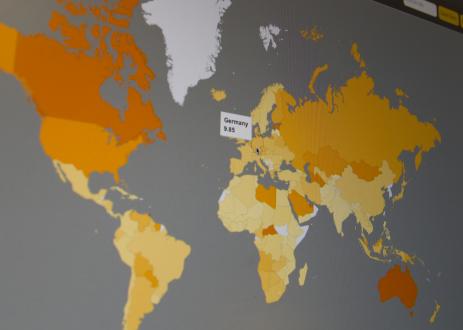A Recommended Methodology for Estimating and Reporting the Potential Greenhouse Gas Emissions from Fossil Fuel Reserves

Synopsis
This working paper outlines a recommended methodology for estimating and reporting the potential emissions from fossil fuel reserves held by coal, oil, and gas companies. The overall goal is the availability of transparent, credible, and consistent data on potential emissions that help illuminate companies’ effects on the carbon budget and inform investment strategies and decisions to use reserves. While the methodology can be directly used by fossil fuel companies to disclose potential emissions data, other groups, such as civil society organizations, investors, and stock market listing authorities, can use the methodology indirectly to press for disclosure.
Key Findings
The extraction and use of the fossil fuels in companies’ reserves would significantly exceed the remaining carbon budget for a 2°C temperature rise over preindustrial levels, leading to more frequent and severe extreme weather events, accelerated sea-level rise, and damage to infrastructure. In the Paris Agreement national governments committed to achieve net-zero greenhouse gas emissions in the second half of this century, limit temperature rise to well below 2 degrees 2°C, and pursue efforts to limit temperature rise to 1.5°C. Attainment of these commitments will require the fossil fuel industry to leave part of its reserves in the ground, at least in the absence of any commercially viable, large-scale carbon capture technology. It is imperative that fossil fuel companies, their shareholders, and other stakeholders have the information they need to make sound decisions in light of this need. Estimates of the potential emissions from fossil fuel companies’ reserves is an important input into such decision-making, but no established methodology exists for estimating and disclosing these emissions. This paper presents such a methodology (Table 4), with the understanding that it is likely to be revised over time as companies become more practiced in applying it.
Key recommendations include the following:
- 作为起点,请使用石油资源管理系统(用于石油和天然气)和矿产储量委员会国际报告标准模板(用于煤炭)或一致的国家法规,以量化化石燃料储量的规模。
- 对于石油和天然气:加上内部操作中用作燃料的化石燃料量。
- 加上通过燃烧,发泄和逃犯活动从内部操作中损失的化石燃料量。
- Use calculation methods detailed in body of this paper to estimate the GHG emissions from fossil fuel combustion and the CH4 emissions from leakage.
- Do not account for projected carbon storage from CCS projects.
- 单独报告已验证和可能的储量中的潜在排放。
- Report key assumptions and the sources of emission factors used.
Executive Summary
In the Paris Agreement national governments committed to limit temperature rise to well below 2 degrees Celsius (°C) and pursue efforts to limit temperature rise to 1.5°C. To meet even a 2°C target, anthropogenic activities could only emit 986 GtCO2 between 2011 and 2100. This number is our global emissions budget. Earth’s coal, oil, and gas reserves are key to this budget. The potential CO2 emissions from reserves currently held by the largest 200 public companies (by reserve size) is at least 1,541 GtCO2, easily exceeding the budget. The degree to which these reserves are exploited will therefore help shape the severity of climate change.
尽管化石燃料公司的储量具有潜在的CO2排放,但目前尚未由任何公司披露它们。财务报告和行业管理标准的重点是储备金规模,不包括计算温室气体(GHG)排放的方法。同时,公司温室气体报告标准的重点是历史排放,因此忽略了化石燃料公司气候影响的最重要部分。必威官网是真的吗
该工作论文概述了这些排放量的公司会计和披露的推荐方法。总体目标是提供透明,可信和一致的潜在排放数据的可用性,这些数据有助于阐明公司对碳预算的影响,并为投资策略和决策提供了使用储备的影响。尽管化石燃料公司可以直接使用该方法来披露潜在的排放数据,但其他群体,例如民间社会组织,投资者和股票市场上市机构,可以间接地使用该方法来敦促披露。
A number of technical issues affect the credibility of potential emissions data. For example, multiple emissions sources may influence overall amounts of potential emissions. While the downstream combustion of sold fossil fuels generates most of the potential emissions from most reserves, fossil fuel production and processing operations can also be important, depending on the reserve type and technologies used. Further, not all of the carbon in reserves is necessarily emitted to the atmosphere; some may be stored in long-lived products or underground through carbon capture and storage (CCS) projects. Reasonable estimates of potential emissions may therefore require looking beyond the sales quantities reported in reserves estimates.
In addition, the estimates are forecasts of the aggregate emissions that could unfold over periods as long as several decades. They are based on assumptions about economic and regulatory conditions, as well as technologies, which can easily change over the productive life of individual deposits. The estimates therefore have relatively high uncertainty and are subject to change.
This paper outlines a recommended methodology for how fossil fuel companies should take these issues into account when estimating and disclosing potential emissions from fossil fuel reserves. Key recommendations include the following:
- 作为起点,请使用石油资源管理系统(用于石油和天然气)和矿产储量委员会国际报告标准模板(用于煤炭)或一致的国家法规,以量化化石燃料储量的规模。
- 对于石油和天然气:加上内部操作中用作燃料的化石燃料量。
- 加上通过燃烧,发泄和逃犯活动从内部操作中损失的化石燃料量。
- Use calculation methods detailed in body of this paper to estimate the GHG emissions from fossil fuel combustion and the CH4 emissions from leakage.
- Do not account for projected carbon storage from CCS projects.
- 单独报告已验证和可能的储量中的潜在排放。
- 报告关键假设和所使用的排放因素的来源。
项目
-

Greenhouse Gas Protocol
启动平台启动平台 访问项目The global standard for companies and organizations to measure and manage their GHG emissions and become more efficient, resilient, and prosperous.
部分 必威官网是真的吗 -


